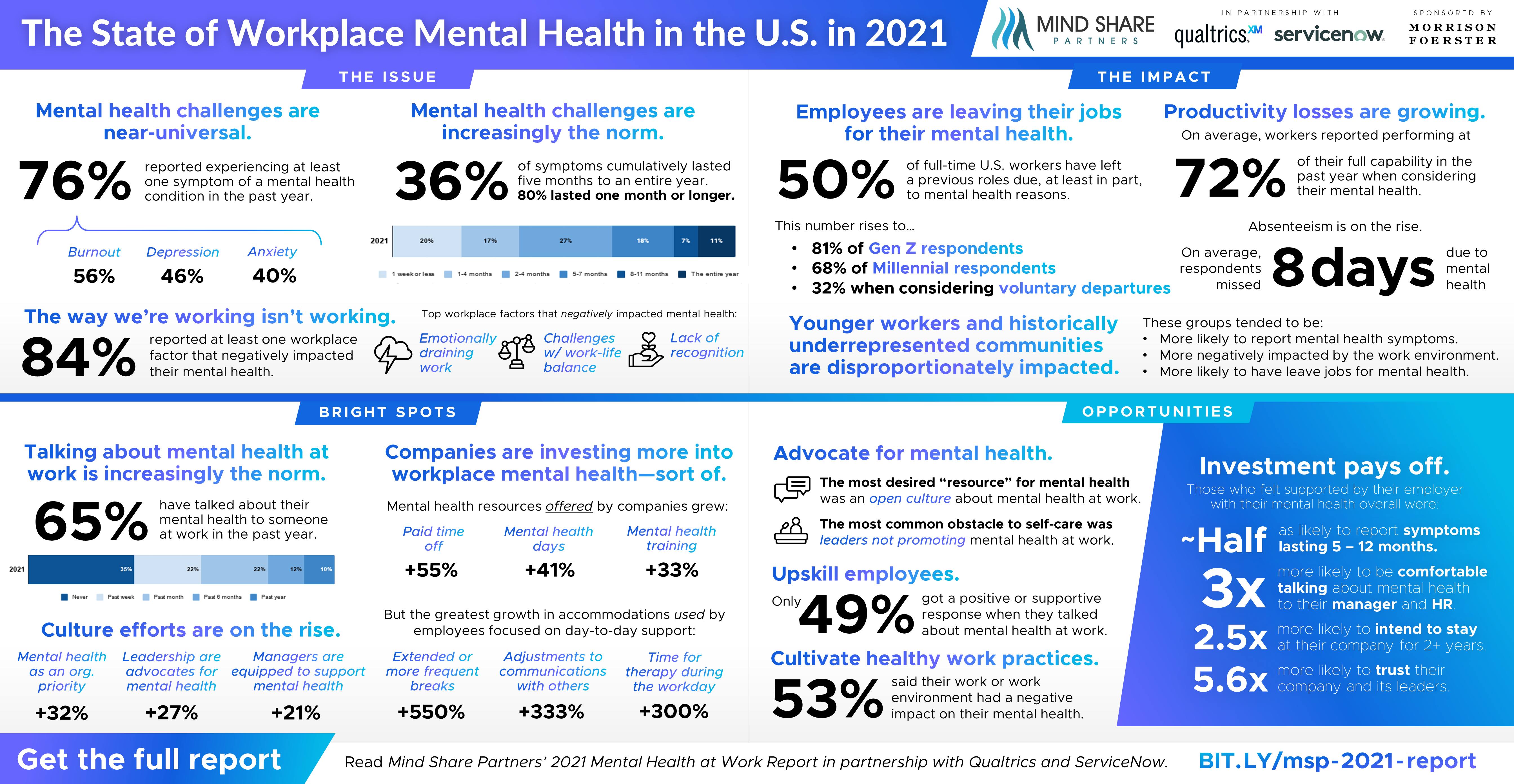Beyond the Score: How Benchmark Data Helps You Build a Healthier Workplace
When you decide to invest in a deeper understanding of workplace health and employee engagement, Best Christian Workplaces offers in-depth and robust...
7 min read
 Al Lopus
:
March, 29 2022
Al Lopus
:
March, 29 2022

The health and well-being of employees have always been part of a flourishing workplace. However, the isolation of the past two years, along with workplace trends going forward, means that the issue of mental health is even more important for leaders and front-line supervisors to understand and address. People are experiencing issues with work-life balance along with anxiety, stress, and depression. Mental health concerns have been a concern for a segment of the population on an ongoing basis, but research shows that mental health struggles are increasing. How do we address the mental health of employees and provide a work environment that helps people flourish?
In this blog post, we will highlight workplace changes and challenges for mental health. Along with research on the current status of mental health, we will focus on practical steps and workplace solutions that enhance the well-being of all employees.
While many organizations are fully returning to in-office work, hybrid work is here to stay, so some employees will be working at least part of the time from alternate locations on an ongoing basis. This combination of online and in-person work means that managers will need to continue to hone their communication skills and build relationships with their employees.
It may be hard to discern how an employee is coping with life when you have limited contact with the person. Now is the time to recommit to regular meetings and check-in times with employees. One-on-one meetings are important between a supervisor and an employee. These times should include intentional questions and a focus on listening more than talking. In addition, time together as a team is important for ongoing relational connections that build effectiveness in teamwork.
A recent BCWI blog post on Manager Effectiveness and Important Ways the Pandemic Changed Work offers additional ideas for caring for employees and building relationships.
When all work was in an office setting, employees still had to manage the issue of work-life balance. The needs of everyday life include regular activities such as a car in the shop, a doctor’s appointment, or a school conference. Employees and employers have had to navigate these competing needs on an ongoing basis.
Now, with hybrid work situations, the boundaries between work and non-work time and space can become blurred. With work being accessible from anywhere, when does the workday start or stop?
Managers and senior leaders can support boundaries between work and non-work time by clear expectations and modeling healthy choices.
While technology has made work possible anywhere and anytime, it also provides ways to set boundaries. Rather than sending out a flurry of emails on a Sunday afternoon, in preparation for the coming week, use the scheduler on your email server and queue up important emails for Monday rather than Sunday. This is true for anyone in an organization, but the example of senior leaders is particularly important. If a senior leader sends an email with a question that needs a response during off-work hours, the employee may feel pressure to respond right away, rather than waiting until their regular workday.
Clarifying expectations for work hours, allowing employees flexibility in scheduling their workday as much as possible, and respecting those parameters when scheduling meetings sends a message to employees that their time and energy are valuable and that it is acceptable to have work boundaries.
Even small habits, such as encouraging people to get up from their desks periodically, or step outside for a few minutes of fresh air, underline the importance of breaks. These small structures, built into a work culture, affirm the value of physical and mental well-being for everyone in an organization. Senior leaders can underscore this value by mentioning how they take breaks during the day.
In addition to daily habits, managers can encourage their employees to schedule and take their paid time off (PTO). Historically, American workers who have PTO do not take all of their allotted days. There may be pent-up demand for time off after the pandemic canceled so many travel plans. A regular rhythm of taking time off work is important for long-term work-life balance.
Mental health struggles are a growing issue in the United States. The above-mentioned structures that provide a good relational foundation and healthy work habits are important, but they are not enough to address the larger issues.
Research on mental health at work shows increased attrition due to mental health reasons, high prevalence of mental health challenges, and widespread disclosure—more employees are talking about their mental health challenges. A study by Mind Share Partners in conjunction with Qualtrics and ServiceNow, published in the Harvard Business Review highlights the issues of mental health in the workplace.
Everyone in your organization needs information about and access to mental health resources. And some people may need extra mental health support.
 Source: Mind Share Partners. https://www.mindsharepartners.org/mentalhealthatworkreport-2021
Source: Mind Share Partners. https://www.mindsharepartners.org/mentalhealthatworkreport-2021
People who regularly interact with and support those who have experienced trauma are susceptible to compassion fatigue or secondary trauma. Secondary traumatic stress is the emotional duress that results when an individual hears about the firsthand trauma experiences of another. This can impact professionals in social work, health care, mental health, and related professions. It also impacts volunteers who work in settings with people who have experienced trauma. If your organization includes people who support those who have experienced trauma, then it is essential to provide mental health resources to equip your staff.
The U.S. Department of Health and Human Services addresses this need and offers resources to identify and provide support to people in caregiving professions:
“Addressing compassion fatigue needs to occur at both the individual and organizational levels and falls into two categories: prevention and treatment. Helpers can adopt lifestyle and work habits that help them maintain strong practice approaches and personal boundaries that can be protective in relation to a helping role. Sometimes even the most seasoned and personally balanced professionals find themselves struggling with secondary traumatization.”
If the mission of your organization includes people who are likely to experience secondary trauma, make assessment and resource provision part of the regular check-ins with supervisors and employees.
Sometimes Christians struggle to offer effective support to those who have mental health issues. At the same time, people who are experiencing mental health struggles might first turn to a pastor or church leader for help. Our Christian faith does compel us to prayer and seeking God’s help, and this faith does not preclude Christians from seeking professional help for mental health struggles.
To address the need for biblically and scientifically accurate understanding of mental health issues, Matthew S. Stanford, Ph.D. wrote Grace for the Afflicted: A Clinical and Biblical Perspective on Mental Illness. As both a church leader and a professor of psychology and behavioral sciences, Stanford has seen far too many mentally ill brothers and sisters damaged by well-meaning believers who respond to them out of fear or misinformation rather than grace. In his book, Stanford presents insights into our physical and spiritual nature and discusses the appropriate role of psychology and psychiatry in the life of the believer. Matthew Stanford now serves as the CEO of the Hope and Healing Center and Institute in Houston, Texas.
In Grace for the Afflicted, Stanford discusses the role of the church in helping people with mental illness. While he is specifically addressing churches and church staff, Christian leaders in other areas can learn from his wisdom:
As the body of Christ, we are called to share the good news, make disciples, love one another, bear one another's burdens, and pray for one another. Unfortunately, the response within the church toward the mentally ill has been to withdraw, either by characterizing them as sinful or by ignoring the problem altogether. …
Stigma and shame are barriers that keep suffering individuals from receiving the care and support they need to recover. It is the responsibility of the clergy and ministry staff to educate the congregation that the church is a safe place to discuss our problems, including mental illness. …
Perhaps even more important, the congregation must be educated about the process the church has put in place to care for and support those who are struggling with mental health problems. Do not assume that they know. A recent LifeWay Research study found that while 68 percent of pastors reported their church kept a list of local mental health referrals for members, only 28 percent of their congregants reported that they knew about it. (From Grace for the Afflicted, Chapter 16, Mental Health and the Church)
Christians regularly seek medical help for physical conditions such as diabetes or heart disease. In the same way, Christians should be encouraged to receive professional help for mental health struggles.
Start with honest self-examination. Are there areas where you are struggling with work-life balance, boundaries, stress, or anxiety? If you are experiencing mental health challenges, take positive steps to get help for your own issues. You cannot lead others into a flourishing workplace if you are on empty! Your own well-being is worth the investment of time and energy.
Consider the status of your workplace. Are senior leaders and managers regularly affirming the need for relational connection and work-life balance? Is there support for positive steps to deal with stress and anxiety in the workplace? The Best Christian Workplaces Institute Employee Engagement Survey addresses some of these topics. If you have not recently done an assessment of your workplace culture, now is a great time to start.
Schedule specific topics related to mental health into staff gatherings in the next month and quarter. Also, while messages related to benefits and mental health resources may come from your human resources department, senior leadership can underscore the value of seeking mental health support by reinforcing messages from HR.
Creating a flourishing workplace, with engaged employees who are thriving, is an ongoing process. Take steps toward flourishing today.

When you decide to invest in a deeper understanding of workplace health and employee engagement, Best Christian Workplaces offers in-depth and robust...

More than ever before, companies are investing in the health and wellness of their employees. In fact, according to the 2022 Employee Wellness...

Why Good Supervisors are Key in Building a Remote Work Culture that Works Remote work arrangements are nothing new and prior to 2020 and the COVID-19...